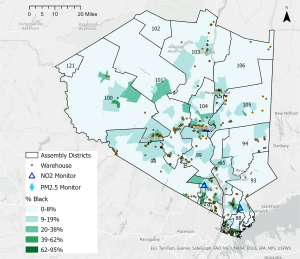The Watchlist
New York’s Mega-Warehouse Watchlist identifies five legislative districts in different regions across the state with the highest concentrations of mega-warehouses, facilities 50,000 square feet and greater. These warehouses attract hundreds to thousands of diesel truck trips per day and expose nearby communities to elevated risks of asthma, bronchitis, and heart disease.

What is an e-commerce mega warehouse?
E-commerce mega-warehouses are facilities that are used to facilitate deliveries directly to customers. They are increasingly sited in or near urban areas and are used to sort, consolidate, and distribute packages for delivery to customers’ homes or businesses. E-commerce mega-warehouses play a critical role in the e-commerce and logistics industry, as they allow for the efficient and timely delivery of goods to customers, but they also generate significant emissions from the large number of delivery trucks that come in and out of the facility, which adversely impacts workers and can contribute to poor air quality in surrounding communities. These emissions are not only harmful but currently unregulated – leaving it to the industry to set voluntary rules for themselves.

Background
All New Yorkers deserve to breathe clean air, but that progress is being put to risk by careless actions from mega e-commerce companies. These corporations’ e-commerce warehouses are popping up across New York with reckless abandon and polluting the most vulnerable New York communities where these e-commerce warehouses are being clustered.
1 in 4 New Yorkers live within a half-mile of an e-commerce mega-warehouse, but these warehouses are not equally distributed. Black, Hispanic/Latino, and low-income populations live near warehouses at rates that are more than 59 percent, 48 percent, and 42 percent higher. Black residents in the Five Boroughs are 1.2 times more likely to live near a warehouse. This inequity in proximity is even higher in Western and Central NY, where Black residents are 2.2 times more likely to live next to a warehouse. Our most vulnerable New Yorkers, including children and seniors, are more likely to experience elevated rates of asthma, heart disease, and other pollution-related health issues due to their proximity to warehouses and the diesel trucks servicing them. We need urgent action to address the environmental and health impacts of warehouse-related pollution.
New York City
In New York City, 3 million people live within half a mile of a warehouse. This exposes them to hundreds to thousands of diesel truck trips per day.
- Black residents are 14% more likely to live within half a mile of a warehouse than would be expected based on the region’s demographics.
- Hispanic/Latino residents are 10% more likely to live within half a mile of a warehouse.
- Low-income residents are 16% more likely to live within half a mile of a warehouse.
Legislative DISTRICT & representative |
Percent of population living within 1/2 mile of a mega-warehouse |
|---|---|
| ASSEMBLY DISTRICT 50 REP. EMILY GALLAGHER Brooklyn: Greenpoint & Williamsburg |
98% live within 1/2 mile of a mega-warehouse |
| ASSEMBLY DISTRICT 53 REP. JO ANNE SIMON Brooklyn: Downtown Brooklyn & Carroll Gardens |
94% live within 1/2 mile of a mega-warehouse |
| ASSEMBLY DISTRICT 37 REP. CLAIRE VALDEZ Queens: Long Island City & Ridgewood |
93% live within 1/2 mile of a mega-warehouse |
| ASSEMBLY DISTRICT 53 REP. MARITZA DAVILA Brooklyn: East Williamsburg & Bushwick |
93% live within 1/2 mile of a mega-warehouse |
| ASSEMBLY DISTRICT 57 REP. PHARA SOUFFRANT FORREST Brooklyn: Fort Greene & Clinton Hill |
91% live within 1/2 mile of a mega-warehouse |
LONG ISLAND
On Long Island, 2.7 million people live within half a mile of a warehouse. This exposes them to hundreds to thousands of diesel truck trips per day.
- Black residents are 53% more likely to live within half a mile of a warehouse than would be expected based on the region’s demographics.
- Hispanic/Latino residents are 45% more likely to live within half a mile of a warehouse.
- Low-income residents are 22% more likely to live within half a mile of a warehouse
Legislative DISTRICT & representative |
Percent of population living within 1/2 mile of a mega-warehouse |
|---|---|
| ASSEMBLY DISTRICT 19 REP. EDWARD P. RA Garden City, Mineola, New Hyde Park |
43% live within 1/2 mile of a mega-warehouse |
| ASSEMBLY DISTRICT 13 REP. CHARLES D. LAVINE Glen Cove, Westbury, Bayville, Sea Cliff |
43% live within 1/2 mile of a mega-warehouse |
| ASSEMBLY DISTRICT 11 REP. KWANI O’PHARROW Lindenhurst, Amityville, North Lindenhurst |
41% live within 1/2 mile of a mega-warehouse |
| SENATE DISTRICT 4 REP. MONICA MARTINEZ Deer Park, North Bay Shore, West Babylon |
40% live within 1/2 mile of a mega-warehouse |
| ASSEMBLY DISTRICT 6 REP. PHIL RAMOS Bay Shore, Baywood, Brentwood, Central Islip, Islandia |
39% live within 1/2 mile of a mega-warehouse |
HUDSON VALLEY
In the Hudson Valley, 486,000 people live within half a mile of a warehouse. This exposes them to hundreds to thousands of diesel truck trips per day.
- Black residents are 90% more likely to live within half a mile of a warehouse than would be expected based on the region’s demographics
- Hispanic/Latino residents are 64% more likely to live within half a mile of a warehouse.
- Low-income residents are 51% more likely to live within half a mile of a warehouse.
Legislative DISTRICT & representative |
Percent of population living within 1/2 mile of a mega-warehouse |
|---|---|
| SENATE DISTRICT 36 REP. JAMAAL T. BAILEY North Bronx, Mount Vernon, Wakefield |
76% live within 1/2 mile of a mega-warehouse |
| ASSEMBLY DISTRICT 89 REP. J. GARY PRETLOW Mount Vernon, Yonkers |
67% live within 1/2 mile of a mega-warehouse |
| SENATE DISTRICT 34 REP. NATHALIA FERNANDEZ Bronx: Parkchester, Pelham Bay, Castle Hill |
44% live within 1/2 mile of a mega-warehouse |
| ASSEMBLY DISTRICT 90 REP. NADER J. SAYEGH Yonkers: Lincoln Park, Bryn Mawr Park, Centuck |
41% live within 1/2 mile of a mega-warehouse |
| SENATE DISTRICT 35 REP. ANDREA STEWART-COUSINS Yonkers: Park Hill, Whitney Young, Lincoln Park |
35% live within 1/2 mile of a mega-warehouse |
WESTERN NEW YORK
In the Hudson Valley, 680,000 people live within half a mile of a warehouse. This exposes them to hundreds to thousands of diesel truck trips per day.
- Black residents are 142% more likely to live within half a mile of a warehouse than would be expected based on the region’s demographics.
- Hispanic/Latino residents are 97% more likely to live within half a mile of a warehouse.
- Low-income residents are 78% more likely to live within half a mile of a warehouse.
Legislative DISTRICT & representative |
Percent of population living within 1/2 mile of a mega-warehouse |
|---|---|
| ASSEMBLY DISTRICT 137 REP. DEMOND MEEKS Rochester: Gates, 19th Ward, United Neighbors Together |
59% live within 1/2 mile of a mega-warehouse |
| ASSEMBLY DISTRICT 141 REP. CRYSTAL PEOPLE-STOKES Buffalo: Willert Park, Fruit Belt, MLK Park, Broadway-Fillmore |
52% live within 1/2 mile of a mega-warehouse |
| SENATE DISTRICT 63 REP. APRIL MCCANTS-BASKIN Buffalo: Lackawanna, Larkniville, Cheektowaga |
47% live within 1/2 mile of a mega-warehouse |
| ASSEMBLY DISTRICT 143 REP. PATRICK CHLUDZINSKI Buffalo: Cleveland Hill, Depew, Bowmansville, Lancaster |
43% live within 1/2 mile of a mega-warehouse |
| ASSEMBLY DISTRICT 119 REP. MARIANNE BUTTENSCHON Marcy, Rome, Deerfield, Air City, Coonrod |
35% live within 1/2 mile of a mega-warehouse |
Solution: Clean Deliveries Act
As e-commerce continues to grow and more consumers purchase goods online, the number of delivery trucks on the road will continue to increase, which leads to a rise in greenhouse gas and health-harming emissions. Without legislation, emissions will continue to disproportionately harm low-income, communities of color and could thwart the achievement of the Climate Leadership and Community Protection Act. But the Clean Deliveries Act (S.2127/A.1718) can address many of these issues.
The Clean Deliveries Act addresses the impacts of warehouses by establishing an indirect source rule for warehouses engaged in storage, distribution, redistribution, processing and sorting that exceed 50,000 square feet. Key provisions of the bill include:
- An air emissions reduction plan requiring warehouse operators to implement one or more of the following: Acquiring zeroemission vehicles and charging infrastructure, installing solar panels and/or batteries on-site, considering alternative transportation modes for incoming or outgoing trips where appropriate and with on-site worker input or paying fees.
- Enhanced protections for warehouses operating in disadvantaged communities or that impact schools and similar facilities.
- A permit requirement for new warehouse developments or those proposing significant modifications.
- Ongoing reporting requirements related to on-site emissions and emissions mitigation measures.
- A zero-emission zones study on the feasibility, benefits and costs of implementing low- and zero-emission designated areas for air pollution and congestion hotspots.
Act Now
The Clean Deliveries Act (S.2127/A.1718) is a powerful first step we can take to protect communities from the severe health impacts of mega-warehouse pollution. The Clean Deliveries Act requires these mega-warehouses to develop emissions and monitoring plans for their operations. Passing the Clean Deliveries Act is a critical next step towards achieving New York State’s climate mandates, and ensuring that New Yorkers that are burdened with emissions from fossil fuels are prioritized for zero-emission investments. Join the fight to pass this bill!










